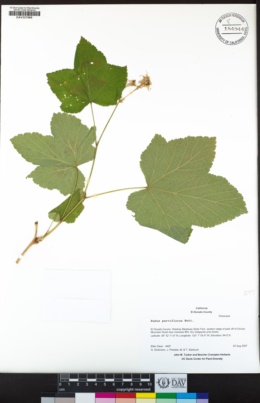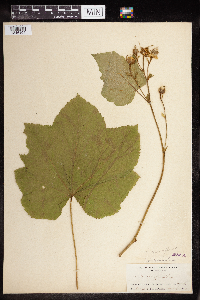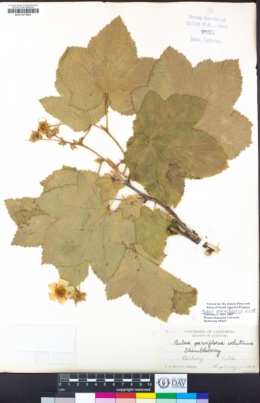Rubus parviflorus
|
|
|
|
Family: Rosaceae
Western Thimble-Berry, more...western thimbleberry, thimbleberry
[Rubacer parviflorum, moreRubacer tomentosum Rydb., Rubacer velutinum (W.H. Brewer) A. Heller, Rubus nutkanus var. velutinus W.H. Brewer, Rubus parviflorus f. paratrichophorus Fassett] |
Plant: shrub; (0.1-)1-2(-3) m tall; stems not strongly differentiated into primocanes and floricanes; bark shredding; plants usually puberulent and stipitate-glandular; prickles absent Leaves: deciduous, slightly larger on first-year's growth, simple, palmately lobed, irregularly serrate to dentate, broadly ovate-cordate, pubescent above, subglabrous and often glandular below, 4-15(-25) cm long, 5-30 cm wide; lobes (3-)5(-7), the lobes acute to acuminate INFLORESCENCE: simple bracteate cymes terminating floricane branches or in leaf axils with 1-9 flowers Flowers: sepals spreading to ascending, caudate, 8-19 mm long, glandular-pubescent, the basal portion ovate to lanceolate; petals white, (8-)11-28 mm long; ovaries capped with a hard pubescent cushion; styles glabrous Fruit: coherent, thimble-shaped, separating from the torus, merely palatable; drupelets red, pubescent, thinly-fleshy Misc: Shady mesic forest areas; 2150-3250 m (7000-10800 ft); Jun-Sep REFERENCES: Brasher, Jeffrey W. 2001. Rosaceae. J. Ariz. - Nev. Acad. Sci. Volume 33(1). Jepson 2012, Kearney and Peebles 1969, McDougall 1973 Common Name: thimbleberry Duration: Perennial Nativity: Native Lifeform: Subshrub Wetland Status: FACU, FAC+ General: Herbaceous to suffrutescent or shrubby perennials, to 2 m tall, stems erect or nearly so, not angled and without prickles, glabrous to finely hairy with stalked glands, not glaucous, the bark becoming shreddy with age, not rooting at the tips. Leaves: Alternate, large, simple, and palmately 3-5 lobed, broadly ovate in outline, 5-15 cm wide and long, with cordate bases, surfaces glabrous, sometimes pubescent below, blades petioled with conpicuous stipules. Flowers: White or tinged with pink, perfect, petals 5, elliptic, 15-20 mm long, sepals pubescent, 10-15 mm long with abrupt, tail-like and spreading to reflexed tips, hypanthiums saucer-shaped, stamens numerous, pistils numerous, ovaries superior, flowers few in terminal corymbs 2-5 cm across (flat or round-topped infloresences). Fruits: Red, hemispheric, fleshy and aggregate fruits formed of drupelets crowded on a convex receptacle (like a blackberry). Ecology: Found in the mountians at high elevations from 8,000-9,500 ft (2438-2896 m); flowering June-September. Distribution: Michigan to Alaska, south to New Mexico, Arizona, and California. Ethnobotany: Specific uses for this variety are unknown, but the species has uses; young sprouts considered a valuable alterative, antiscorbutic, poultice of dried leaves applied to burns, wounds, or poultice of leaf ashes and grease applied to swellings, decoction of leaves taken for vomiting, blood spitting, anemia and to strengthen the blood, for when a woman's period was unduly long, dried, powdered leaves eaten for internal disorders, diarrhea, stomachaches, infusion of roots taken by thin people as an appetizer or tonic, or by young people with pimples and blackheads, berries given by diviners to patients to eat for chest disorders, green insect galls found on the stems burned & the ashes rubbed on babies' navels if they did not heal, and young sprouts peeled and eaten in spring, Berries used for food or soaked in water to make a beverage, fish boiled with leaves as flavoring and kept the fish from sticking to the pot, and roots used for sugar. Editor: LCrumbacher2012 Etymology: Rubus is a Latin name for "bramble" or "blackberry" from ruber, "red", and parviflorus comes from the Greek parvus, "small," and flora, "flower," hence "small-flowered". Unarmed shrub 1-2 m, the younger parts, petioles, and pedicels usually stipitate-glandular; lvs rotund to reniform in outline, 1-2 dm wide, shallowly ca 5-lobed, the lobes serrate, acute; fls few, white, in a long-pedunculate cymose cluster; sep with orange-yellow very short gland-tipped hairs; pet elliptic-ovate, 1.5-2 cm; fr juicy, edible, red, 1.5 cm thick, pubescent, falling as a unit from the persistent receptacle; 2n=14. Open woods and thickets; Bruce Peninsula, Ont., to n. Mich. and n. Minn.; S.D.; widespread in the western cordillera. May-July. (Rubacer p.) Gleason, Henry A. & Cronquist, Arthur J. 1991. Manual of vascular plants of northeastern United States and adjacent Canada. lxxv + 910 pp. ©The New York Botanical Garden. All rights reserved. Used by permission. |
|
|
|





























































































